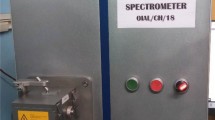Abstract
It is of great theoretical significance and engineering value to predict the weld shape for selecting welding parameters. A simplified and efficient three-dimensional (3D) heat conduction model was established to predict weld shape in fiber laser keyhole welding. An improved hybrid heat source model was proposed which consisted of a surface heat flux with a Gaussian distribution and a cylindrical heat source with damped peak value through the depth. The simulation results quite coincided with experimental ones, which indicated that the improved hybrid heat model can explain the energy absorption in keyhole more accurately. Both partially and fully penetrated weld shapes and sizes were predicted. The results showed that prediction errors of the sizes of weld cross-sections in partial-penetration welding were less than 8.9 %. While in full-penetrated welds, they were less than 8.8 % except for size of weld waist.
Similar content being viewed by others
References
DebRoy T, David SA (1995) Physical processes in fusion welding. Rev Mod Phys 67:85–116
Kaplan A (1994) A model of deep penetration laser welding based on calculation of the keyhole profile. J Phys D Appl Phys 27:1805–1814
Kazemi K, Goldak JA (2009) Numerical simulation of laser full penetration welding. J Comput Mater Sci 44:841–849
Manonmani K, Murugan N, Buvanasekaran G (2007) Effects of process parameters on the bead geometry of laser beam butt welded stainless steel sheets. Int J Adv Manuf Technol 32:1125–1133
Li XB, Lu FG, Haichao Cui HC, Xinhua Tang XH, Wu YX (2014) Numerical modeling on the formation process of keyhole-induced porosity for laser welding steel with T-joint. Int J Adv Manuf Technol 72:241–254
Mazumder J, Steen WM (1980) Heat transfer model for CW laser material processing. J Appl Phys 51:941–947
Lankalapalli KN, Tu JF, Gartner M (1996) A model for estimating penetration depth of laser welding processes. J Phys D Appl Phys 29:1831–1841
Bonollo F, Tiziani A, Zambon A (1993) Model for CO2 laser welding of stainless steel, titanium and nickel: parametric study. Mater Sci Technol 9:1137–1145
Belhadja A, Bessroura J, Masse J (2010) Finite element simulation of magnesium alloys laser beam welding. J Mater Process Technol 9:1131–1137
Moraitis GA, Labeas GN (2008) Residual stress and distortion calculation of laser beam welding for aluminum lap joints. J Mater Process Technol 32:60–269
Moraitis GA, Labeas GN (2009) Prediction of residual stresses and distortions due to laser beam welding of butt joints in pressure vessels. Int J Pres Ves Pip 86:133–142
Capriccioli A, Frosi P (2009) Multipurpose ANSYS FE procedure for welding processes simulation. Fusion Eng Des 84:546–553
Chu QC (2010) Simulation of temperature field in laser lap welding for stainless steel. China Laser 37:3180–3186
Wei YH (1999) Numerical simulation of solidification crack and temperature field in welding. Trans China Weld 20:199–204
Ducharme R, Williams K, Kapadia P (1994) The laser welding of thin metal sheets: an integrated keyhole and weld pool model with supporting experiments. J Phys D Appl Phys 27:1619–1627
Dhahri M, Masse JE, Mathieu JF, Barreau G, Autric M (2001) Laser welding of AZ91 and WE43 magnesium alloys for automotive and aerospace industries. Adv Eng Mater 3:504–507
Lee JY, Ko SH, Farson DF (2002) Mechanism of keyhole formation and stability in stationary laser welding. J Phys D Appl Phys 35:1570–1576
Cho JH, Na SJ (2006) Implementation of real-time multiple reflection and Fresnel absorption of laser beam in keyhole. J Phys D Appl Phys 39:5372–5378
Tsirkas SA, Papanikos P, Kermanidis T (2003) Numerical simulation of the laser welding process in butt-joint specimens. J Mater Process Technol 134:59–69
Ducharme R, Kapadia P, Dowden J, Mathematical model of the defocusing of laser light above a workpiece in laser material processing. In: Proceedings of SPIE-The International Society for Optical Engineering. Beijing, China, pp. 187–197
Author information
Authors and Affiliations
Corresponding author
Additional information
Peiyun Xia and Fei Yan contributed equally to this work.
Rights and permissions
About this article
Cite this article
Xia, P., Yan, F., Kong, F. et al. Prediction of weld shape for fiber laser keyhole welding based on finite element analysis. Int J Adv Manuf Technol 75, 363–372 (2014). https://doi.org/10.1007/s00170-014-6129-4
Received:
Accepted:
Published:
Issue Date:
DOI: https://doi.org/10.1007/s00170-014-6129-4



